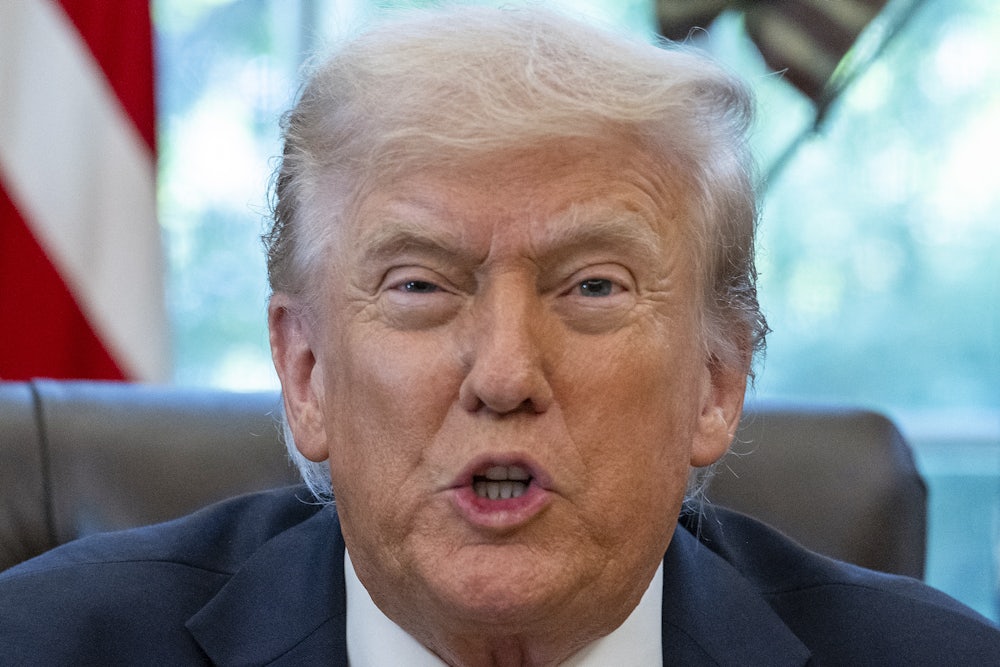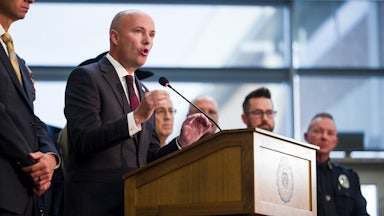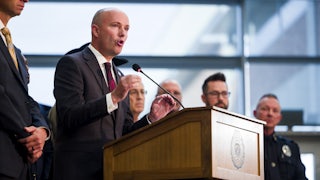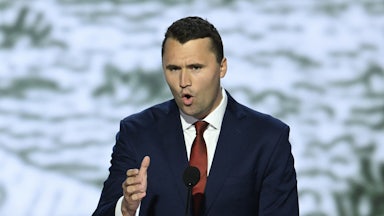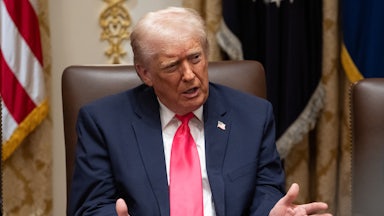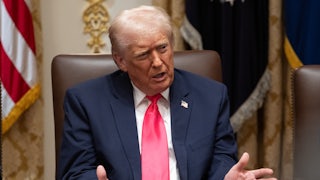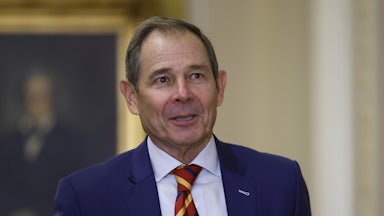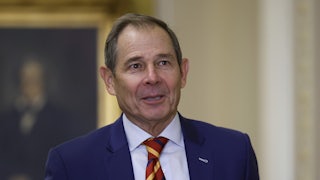The assassination of Charlie Kirk was a terrible act of violence that cut short the life of a 31-year-old human being. It was also a political opportunity—not for the left, as Kirk’s mentally disturbed killer may have believed, but for the right, which, as many have noted, instantly turned him into the Trumpian version of Horst Wessel.
Two weeks after Kirk’s killing, Trump issued a presidential memorandum criminalizing opinions that are “anti-capitalism” or “anti-Christianity”; that represent “extremism” with regard to “migration, race, and gender”; or that express “hostility towards those who hold traditional American views on family, religion, and morality.” These thought crimes are to be prosecuted in the name of “Countering Domestic Terrorism and Organized Political Violence.” It’s the most sweeping government crackdown on dissent since J. Edgar Hoover’s notorious COINTELPRO—and it may end up being much more harmful.
A powerful myth has long existed in the United States that the political left is historically more violent than the political right. In fact, the opposite is true, as documented by many sources, including a 2021 report by The Washington Post in collaboration with the Center for Strategic and International Studies, or CSIS; a 2022 University of Maryland study; and a 2022 study by the FBI and the Department of Homeland Security.
Right-wing political violence is not only more common, it’s also more likely to be judged legitimate by those in whose name it’s committed. A November 2021 poll by the nonprofit Public Religion Research Institute found three times as many Republicans as Democrats agreed with the statement, “Because things have gotten so far off track, true American patriots may have to resort to violence in order to save our country.” In November 2022, I posted a piece here under the headline: “‘We’ Don’t Have a Political Violence Problem. Republicans Do.”
That may no longer be true. Trump has been riling the left through a decade of hateful provocations, starting with his 2015 presidential announcement’s assertion that Mexican immigrants were “bringing drugs, they’re bringing crime, they’re rapists.” CSIS reported last month that these efforts have finally borne fruit:
Left-wing violence has risen in the last 10 years, particularly since President Donald Trump’s rise to political prominence in 2016.… More contentious politics in the United States and the expansion of the Make America Great Again (MAGA) movement appear to have reenergized violent left-wing extremists.
Mind you, the increase in left-wing violence is from “very low levels and remains much lower than historical levels of violence carried out by right-wing and jihadist attackers.” (The latter represent a third category.) Left-wing killers have a long way to go before they reach the level of sustained political violence achieved by white supremacists, neo-Nazis, Jew-haters, Islamaphobes, homophobes, and many more.
Just to be clear: I abhor all violence, political or otherwise, left and right. Vandalism, too. (Before you ask: Yes, I said this when the George Floyd protests turned into riots.) That’s a moral judgment. In addition, I make the political judgment that political violence (and vandalism) is self-destructive, especially when committed by the left. (The right doesn’t tend to pay as high a price for breaking things and hurting people.)
I therefore take no joy in reporting that Trump’s extremist rhetoric and increasingly authoritarian policies have, according to CSIS, made 2025 “the first time in more than 30 years that left-wing attacks outnumber those from the far right.” Granted, left-wing political violence remains less lethal. Right-wing nuts killed 112 people between 2016 and the middle of 2025; the body count for left-wing nuts is a paltry 13. I don’t see that gap closing, given the left-of-center’s dislike of assault weapons. And I wouldn’t count on the left remaining more violent than the right into 2026, given the right’s historic advantage going back at least to the 1940s. It isn’t really, as the cliché goes, who the left is.
But this year’s surge has given Trump a pretext, and he’s taking maximum advantage. In the 1960s, Hoover infiltrated radical and so-called radical groups. Trump’s instinct is to follow the money. A National Joint Terrorism Task Force will target “individual and institutional funders, and officers and employees of organizations, that are responsible for, sponsor, or otherwise aid and abet the principal actors” in domestic terrorism. That’s a very broad brush. So is the memo’s definition of “domestic terrorism,” which includes “trespass,” “doxing,” and “civil disorder,” whatever that means. On the same day the memo was issued, Aakash Singh, who works in the office of Deputy Attorney General Todd Blanche, sent a separate memo to U.S. attorneys directing them to prosecute George Soros’s Open Society Foundations for material support for terrorism and other crimes.
The Washington law firm Wilmer Hale, which is nobody’s idea of a left-wing alarmist, immediately warned its nonprofit clients that the result will be IRS investigations, “potential terrorism designations for organizations viewed as promoting progressive causes,” and “attempts to block assets of nonprofit organizations.” In a similar vein, Arnold & Porter said, “By targeting tax-exempt organizations and funders targeted based on ideological considerations, the Presidential Memorandum and investigative actions implementing it could raise significant issues under the First Amendment.”
It may be hard for Trump to get convictions, but winning in court probably isn’t his aim; it never has been in the past. As one former counterterrorism lawyer for the Justice Department told Josh Kovensky of Talking Points Memo, “It’s a legal nullity in many respects, but financial institutions don’t care about that.” Translation: This will scare banks away from doing business with liberal nongovernment organizations and other nonprofits. Who needs the hassle?
The money angle mimics the harassment strategy Trump is pursuing in his fight against universities, which he similarly considers domestic enemies. Not only is Trump imposing fines in the hundreds of millions on Ivy League universities, for imaginary violations that wouldn’t stand up in court; he also increased, in the “big, beautiful” reconciliation bill, taxes on the largest university endowments—from 1.4 percent to 8 percent. This change will cost Yale, for instance, $280 million, and no fewer than 17 universities more than $10 million.
To use left-wing violence to justify harassing political opponents, Trump needs to keep the pot bubbling, even at the expense of personal safety. (Recall that there were two attempts last year on Trump’s life.) Sending troops into blue-state cities is mainly, I think, Trump’s strategy to create violent confrontation that he can exploit for political gain. God bless the National Guard, which in my opinion hasn’t received sufficient praise for keeping such confrontations to a bare minimum by hanging out in places (like Los Angeles’s federal building in Westwood and Washington’s National Mall) where confrontation is easily avoided, and by occupying itself with boring tasks like mulching, raking leaves, and picking up trash.
The National Guard doesn’t want another Kent State. But Trump would relish one, no matter who the aggressor was. Recall that although a plurality today may blame the National Guard for killing four students and wounding nine that awful day in May 1970, at the time 58 percent told Gallup they blamed the students and only 11 percent blamed the guard. “When dissent turns to violence,” the Nixon White House said, in a statement on the massacre, “it invites tragedy.” Never mind that only one side had guns.
In his speech to the generals last week, Trump said, “We’re under invasion from within, no different than a foreign enemy, but more difficult in many ways because they don’t wear uniforms.” He didn’t mean left-wing killers; those are his de facto allies. He meant peace-loving opponents—some of them on the right!—who shine a light on the many, many ways he’s damaging this country. Trump’s complaint that “they don’t wear uniforms” emboldened me last week to have a T-shirt made up, white letters on a navy-blue background, that says:
the enemy
within
Many friends complimented me on it. But after reading Trump’s September 25 memorandum, I’m not sure that I’ll wear it anymore outside the house.
